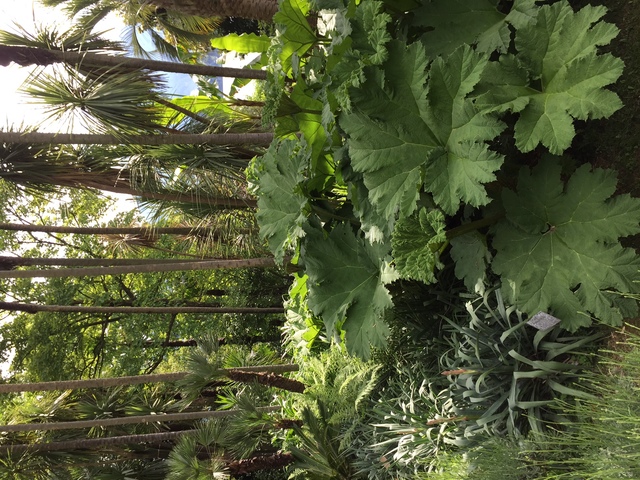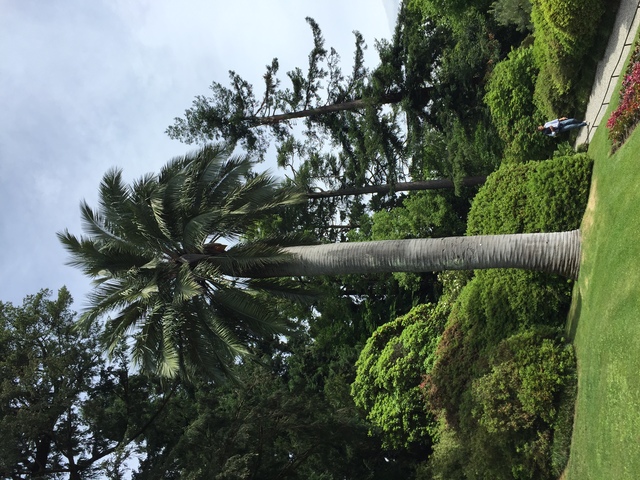We just returned from a big family reunion of the Bezonas, Bezonis and Bisoglios in Northern Italy. We were also hosted by the Toso, Guerra and Giacometti families who have ties to Kona. It was amazing to see how many palms and bamboos were used in the gardens of Lake Como, Lago Magiore, Turino, Milano and even into Switzerland around Lake Lugano. It always seems strange to be enjoying a view of palms, banana plants and bamboos with snowy mountains in the background. Not only did we see the expected windmill palm, (Trachycarpus fortunei), but others like Canary Island date palm, Chilean wine palm, European fan palm, (Chamaerops humilis), Brazilian pindo palm (Butia capitata) and several species of Sabal from the southern United States. A day trip to Genova and the Italian coastline toward France is spectacular with many more species of palms.
The reason why this part of Europe and the French Riviera is blessed with so many palms species is that plant explorers of the 19th century brought them back from other parts of the world to be grown in botanical gardens and ultimately into the grand gardens of the rich and famous. Today, European nurseries supply palms and other tropical appearing plants for everyone to enjoy. Exotic palms have been grown there for more than 150 years and some have actually set viable seeds and naturalized.
Returning to Hawaii via Seattle we had the opportunity to visit several nurseries around the Lake Washington area and were surprised to see the great variety of palms, bamboos, bananas and other subtropicals available. Just 30 years ago it would have been hard to find such a variety unless you went to California nurseries for a source. Now, you can see palms planted in profusion along the lake in communities like Bellvue, Kirkland, Kenmore, Wash., and downtown Seattle.
We can create moods by the kinds of plants, architecture and nonplant elements we use in our gardens, neighborhoods and communities. Cactus and succulents plus lots of bright colors make a garden feel hot and desert like. Using pines, cypress and other high mountain or cool climate plants give the garden a Pacific Northwest look. In Hawaii, East meets West, so we have tremendous latitude in garden design. To me, Bali best reflects the use of plants, sculpture, architecture and water elements to achieve harmony with home and garden. The “Bali look” can best be achieved by using the many palm species available at Hawaii nurseries. Even more rare species may be located through the local chapter of International Palm Society. President Mary Lock just announced an open invitation to visit the Brian/Gibbens rare palm garden Aug. 16. Participants will not only see the palms but how they are best used and maintained in the landscape. Nonmembers will be charged a fee of $5 or may join the society for $10 and receive a rare palm as well. Make reservations with Tim Brian at 333-5626.
Coastal California is a great example of how a tropical look can be achieved in a climate that is cool and damp much of the year. Now we can see this type of landscape design extends as far north as Victoria, British Columbia. However, it is more than the types of plants used. The air of freedom and informality of a tropical looking garden is partly because of the exotic plant materials used, but it is also because of the style of design found throughout the islands of the Pacific. This consists of mixing many bold and colorful shrubs, ground covers and trees in a relaxed, nonregimented manner.
Surprisingly, the tropical jungle look is often more easily maintained than vast open expanses of lawn. Abundant vegetation also supplies more oxygen and reduces noise and visual pollution. Grass is high maintenance, requiring frequent mowing and an abundant supply of water. Shrubs and trees are more deeply rooted and generally take much less care.
Many visitors to the islands wish they could take a bit of the tropics home with them. This is actually possible, since the tropical look can be achieved anywhere there is a place to grow things. It can be achieved with almost any plants, but to best develop that tropical look in cooler climates, the selection of materials should be with those having a bold and colorful tropical presence. Even hardy evergreen shrubs like rhododendrons may be used. Pampas and Arundo grass, hostas, cannas, gunneras and other herbaceous plants may be used as well.
Another tree, not quite so common or hardy, is the Albizzia julibrissin or Persian silk tree. Although very tropical in appearance, with its poinciana-like foliage and pink pompon flowers, this tree will tolerate conditions below zero degrees. The silk tree is native to Asia and can reach heights of up to 40 feet but is usually much smaller, spreading like an umbrella to 20 feet. The tree’s filtered shade allows grass and other plants to grow underneath. It also makes a very good patio tree.
The gingko biloba or maidenhair tree is another “toughie” from China that will tolerate sub-zero temperatures. This tree is a living fossil from the era when tree ferns and palms were growing throughout North America.
When it comes to tree ferns, Hawaii boasts of forests of them. Unfortunately, Hawaii’s tree fern is much too tender to grow out of doors except in the most protected areas of the south. A close relative from New Zealand is much tougher and will take temperatures down to 20 degrees. The New Zealand tree fern, or Dicksonia antarctica, can be grown in protected coastal areas of Washington and Oregon. They are slow growing but will slowly attain trunks of 15 feet if given cool, moist conditions. Ferns are common in the tropics. There are many hardy ferns that may be used to enhance that tropical look in even the coldest gardens.
The Japanese banana, Musa basjoo, is frequently planted in northern Italy. This banana is root hardy and regrows every year even after freezing to the ground. Even taro can be wintered over with mulching along the West Coast, and as far north as Washington, D.C., on the East Coast. Musa sikkimensis from the Himalayas is even more cold hardy. If the stem is wrapped for protection it can reach 10 to 15 feet in mild areas as far north as Seattle.
The list of tropical look-alikes is extensive. You might consider trees like the hardy Eucalyptus species. These include the cider gum and snow gum, which survive temperatures close to zero. When it comes to fruits, the fig, pomegranate, olive, kiwi and loquat can all be found growing as far north as Seattle. Sunset’s National Garden Book will also give you some great ideas. Remember, hardiness fluctuates. You can increase hardiness by plant conditioning and protection. With global climate change you will be surprised what you can grow.






